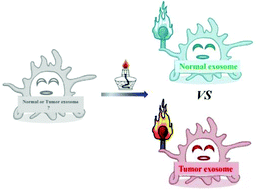A gas-pressure-assisted ratiometric atomic flame assay for the point-of-care testing of tumor-cell-derived exosomes†
Abstract
The multicolor-based point-of-care testing (POCT) of tumor cell-derived exosomes is of vital importance for understanding tumor growth and metastasis. Multicolor-based ratiometric signals most often rely on molecular optics, such as fluorescence resonance energy transfer (FRET)-dependent molecular fluorescence and localized surface plasmon resonance (LSPR)-related molecular colorimetry. However, finding acceptable FRET donor–acceptor fluorophore pairs and the kinetically slow color responses during size-related molecular colorimetry have greatly impeded POCT applications. Herein, an atomic flame was used to develop a visual sensing platform for the POCT of tumor-cell-derived exosomes. In comparison with common molecular optics, the atomic flame possessed the advantages of providing both a variety of ratiometric flame signals and fast response sensitivity. The integration of a gas-pressure-assisted flame reaction and dual-aptamer recognition guaranteed the sensitive and selective analysis of exosomes with a low limit of detection (LOD) of 7.6 × 102 particles per mL. Such a novel optical signal will inspire the development of more user-friendly POCT approaches.

- This article is part of the themed collection: Analyst HOT Articles 2021


 Please wait while we load your content...
Please wait while we load your content...